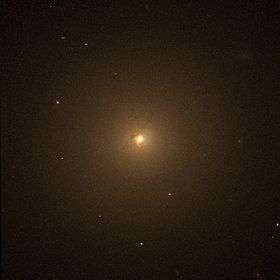NGC 404
| NGC 404 | |
|---|---|
 NGC 404 by Hubble Space Telescope; 1.68′ view | |
| Observation data (J2000 epoch) | |
| Constellation | Andromeda |
| Right ascension | 01h 09m 27.0s[1] |
| Declination | +35° 43′ 04″[1] |
| Redshift | -48 ± 9 km/s[1] |
| Distance | 10.0 ± 0.7 Mly (3.07 ± 0.21 Mpc)[2][3][4][a] |
| Apparent magnitude (V) | 11.2[1] |
| Characteristics | |
| Type | SA(s)0−[1] |
| Apparent size (V) | 3′.5 × 3′.5[1] |
| Other designations | |
| UGC 718, PGC 4126[1] | |
NGC 404 is a field galaxy[5] located about 10 million light years away in the constellation Andromeda. It was discovered by William Herschel in 1784, and is visible through small telescopes.[6] NGC 404 lies just beyond the Local Group and does not appear gravitationally bound to it. It is notable for being within 7 arc-minutes of second magnitude star Mirach, making it a difficult target to observe or photograph and granting it the nickname "Mirach's Ghost".[6][7]
Physical characteristics
NGC 404 is a very isolated dwarf lenticular galaxy, a bit more luminous and smaller than the Small Magellanic Cloud[8] and unlike many other early-type galaxies is very rich in neutral hydrogen, most of it concentrated on a pair of large rings around it.[9] It also has star formation both on its center[10] and on its outermost regions, albeit at a low level[11]
Both the outer gas disk and its star formation are assumed to have been triggered by one or several mergers with smaller galaxies roughly 1 billion years ago[11] and it has been proposed NGC 404 is a former spiral galaxy that was transformed into a lenticular one by that event[10]
LINER emission
NGC 404 contains a low-ionization nuclear emission-line region (LINER), a type of region that is characterized by spectral line emission from weakly ionized atoms.[12] A nuclear star cluster is also present as well as -likely- a supermassive black hole, with a mass of several tens of thousands solar masses[13]
Distance measurements
At least two techniques have been used to measure distances to NGC 404. The infrared surface brightness fluctuations distance measurement technique estimates distances to spiral galaxies based on the graininess of the appearance of their bulges. The distance measured to NGC 404 using this technique in 2003 is 9.9 ± 0.5 Mly (3.03 ± 0.15 Mpc).[2]
However, NGC 404 is close enough that red supergiants can be imaged as individual stars. The light from these stars and knowledge of how they should compare to nearby stars within the Milky Way galaxy allows for direct measurement of the distance to the galaxy. This method is referred to as the tip of the red giant branch (TRGB) method. The estimated distance to NGC 404 using this technique is 10.0 ± 1.2 Mly (3.1 ± 0.4 Mpc).[3] Averaged together, these distance measurements give a distance estimate of 10.0 ± 0.7 Mly (3.07 ± 0.21 Mpc).[a]
Notes
- ^ average(3.03 ± 0.15, 3.1 ± 0.4) = ((3.03 + 3.1) / 2) ± ((0.152 + 0.42)0.5 / 2) = 3.07 ± 0.21
References
- 1 2 3 4 5 6 7 "NASA/IPAC Extragalactic Database". Results for NGC 404. Retrieved 2006-11-18.
- 1 2 Jensen, Joseph B.; Tonry, John L.; Barris, Brian J.; Thompson, Rodger I.; et al. (February 2003). "Measuring Distances and Probing the Unresolved Stellar Populations of Galaxies Using Infrared Surface Brightness Fluctuations". Astrophysical Journal. 583 (2): 712–726. arXiv:astro-ph/0210129. Bibcode:2003ApJ...583..712J. doi:10.1086/345430.
- 1 2 I. D. Karachentsev; V. E. Karachentseva; W. K. Hutchmeier; D. I. Makarov (2004). "A Catalog of Neighboring Galaxies". Astronomical Journal. 127 (4): 2031–2068. Bibcode:2004AJ....127.2031K. doi:10.1086/382905.
- ↑ Karachentsev, I. D.; Kashibadze, O. G. (2006). "Masses of the local group and of the M81 group estimated from distortions in the local velocity field". Astrophysics. 49 (1): 3–18. Bibcode:2006Ap.....49....3K. doi:10.1007/s10511-006-0002-6.
- ↑ Materne, J. (April 1979). "The structure of nearby groups of galaxies - Quantitative membership probabilities". Astronomy and Astrophysics. 74 (2): 235–243. Bibcode:1979A&A....74..235M.
- 1 2 Mirach's Ghost (NGC 404), The Internet Encyclopedia of Science, David Darling. Accessed on line August 15, 2008.
- ↑ "'Ghost of Mirach' Materializes in Space Telescope Image". Jet Propulsion Laboratory. 31 October 2008. Retrieved 26 September 2013.
- ↑ Karachentsev, Igor D.; Karachentseva, Valentina E.; Huchtmeier, Walter K.; Makarov, Dmitry I. (2003). "A Catalog of Neighboring Galaxies". The Astronomical Journal. 127 (4): 2031–2068. Bibcode:2004AJ....127.2031K. doi:10.1086/382905.
- ↑ del Río, M. S.; Brinks, E.; Cepa, J. (2004). "High-Resolution H I Observations of the Galaxy NGC 404: A Dwarf S0 with Abundant Interstellar Gas". The Astronomical Journal. 128 (1): 89–102. arXiv:astro-ph/0403467. Bibcode:2004AJ....128...89D. doi:10.1086/421358.
- 1 2 Bouchard, A.; Prugniel, P.; Koleva, M.; Sharina, M. (2010). "Stellar population and kinematics of NGC 404". Astronomy & Astrophysics. 513. arXiv:1001.4087. Bibcode:2010A&A...513A..54B. doi:10.1051/0004-6361/200913137. A54.
- 1 2 Thilker, David A.; Bianchi, Luciana; Schiminovich, David; Gil de Paz, Armando; et al. (2010). "NGC 404: A Rejuvenated Lenticular Galaxy on a Merger-induced, Blueward Excursion Into the Green Valley". The Astrophysical Journal Letters. 714 (1): L171–L175. arXiv:1003.4985. Bibcode:2010ApJ...714L.171T. doi:10.1088/2041-8205/714/1/L171.
- ↑ Ho, Luis C.; Filippenko, Alexei V.; Sargent, Wallace L. W. (October 1997). "A Search for "Dwarf" Seyfert Nuclei. III. Spectroscopic Parameters and Properties of the Host Galaxies". The Astrophysical Journal Supplement. 112. pp. 315–390. arXiv:astro-ph/9704107. Bibcode:1997ApJS..112..315H. doi:10.1086/313041.
- ↑ Seth, Anil C.; Cappellari, Michele; Neumayer, Nadine; Caldwell, Nelson; et al. (2010). "The NGC 404 Nucleus: Star Cluster and Possible Intermediate-mass Black Hole". The Astrophysical Journal. 714 (1): 713–731. arXiv:1003.0680. Bibcode:2010ApJ...714..713S. doi:10.1088/0004-637X/714/1/713.